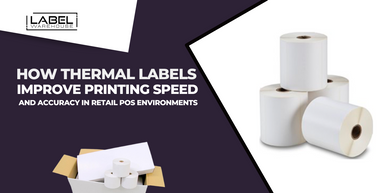Posted by Label Warehouse on 20th Feb 2024
How do Thermal Labels Improve Printing Speed and Accuracy in Retail POS Environments?
In the dynamic realm of retail, operational efficiency stands as a cornerstone for success. The Point of Sale (POS) system, serving as the nerve centre for transactions, plays an indispensable role in orchestrating seamless and rapid customer interactions. A pivotal element instrumental in elevating the efficiency of the POS system is the incorporation of thermal labels. This innovation has brought about a paradigm shift in the printing process, wielding a transformative impact on the speed and accuracy within retail POS environments. The utilisation of thermal labels is a testament to the industry's commitment to streamlining operations, ensuring that each transaction is not only swift but also precise. The integration of these labels represents a progressive step forward in optimising the overall retail experience, as businesses strive to meet the demands of the fast-paced retail landscape.
In this blog post, we'll look into the reasons behind the growing popularity of thermal labels and their positive impact on the retail industry.
What are Thermal Labels?
Thermal labels are a type of labelling material that utilises heat-sensitive paper or direct thermal printing technology for the creation of high-quality prints without the need for ink or toner. These labels are designed to react to heat, typically through thermal printers equipped with heating elements. In the printing process, the thermal printer selectively heats the label's surface, causing the thermal coating to darken and create the desired text, images, or barcodes. This heat-induced reaction eliminates the need for traditional ink or toner cartridges, streamlining the printing mechanism and enhancing efficiency. Thermal labels find widespread application in various industries, particularly in retail, logistics, and healthcare, where their ability to produce fast, legible, and durable prints proves invaluable for tasks such as product labelling, barcode generation, and inventory management. The simplicity, speed, and cost-effectiveness of thermal labels contribute to their popularity as a versatile and efficient solution for a range of labelling needs across different sectors.
Evolution of Thermal Labels
The evolution of thermal labels has been a fascinating journey marked by technological advancements and a persistent pursuit of efficiency in various industries. Initially introduced as an alternative to traditional printing methods, the early thermal labels utilised heat-sensitive materials for producing prints. These labels found early adoption in applications where speed and simplicity were paramount, such as in retail for barcode printing.
Over time, the technology behind thermal labels has undergone significant improvements. The transition from direct thermal printing to thermal transfer printing marked a milestone, allowing for enhanced durability and longevity of prints. In thermal transfer printing, a heated ribbon transfers ink onto the label surface, resulting in more robust and long-lasting prints. This evolution made thermal labels suitable for a broader range of applications, including industries where label durability and resistance to environmental factors are crucial, such as in manufacturing and logistics.
Another noteworthy advancement in the evolution of thermal labels is the development of RFID (Radio-Frequency Identification) technology integration. This has enabled labels to serve not only as a means of visual information but also as carriers of digital data. RFID-enabled thermal labels contribute to improved inventory management, supply chain visibility, and enhanced security measures.
Furthermore, the continuous refinement of materials used in thermal labels has contributed to heightened print quality, resistance to fading, and adaptability to various surfaces. These improvements have expanded the scope of thermal labels to encompass diverse industries, from healthcare for patient identification to horticulture for plant labelling.
As technology continues to progress, the evolution of thermal labels is likely to persist. Innovations in materials, printing mechanisms, and integration with other technologies will further enhance the versatility and efficiency of thermal labels, ensuring their continued relevance in an ever-evolving landscape of labelling and printing solutions.
Different Types of Thermal Labels
Direct Thermal Labels
- Technology: Direct thermal labels rely on heat-sensitive paper that darkens when exposed to the thermal printhead.
- Application: Widely used for short-term labelling applications such as shipping labels, receipts, and tickets. They are commonly found in retail environments for printing barcodes.
Thermal Transfer Labels
- Technology: In thermal transfer labels, a heated ribbon is used to transfer ink onto the label, providing a more durable and long-lasting print compared to direct thermal labels.
- Application: Ideal for applications where label longevity is crucial, such as product labelling, inventory management, and outdoor labelling. These labels find applications in manufacturing, logistics, and healthcare industries.
RFID Labels
- Technology: RFID labels combine thermal printing with Radio-Frequency Identification technology, enabling the storage and retrieval of digital information using radio waves.
- Application: RFID labels are used for advanced tracking and identification purposes. They are employed in supply chain management, inventory tracking, and access control systems. These labels enhance efficiency by allowing for quick and automated data capture.
Colour Thermal Labels
- Technology: These labels use the thermal printing process to create coloured prints, allowing for the incorporation of graphics and color-coded information.
- Application: Particularly useful in industries where visual differentiation is critical, such as product packaging, branding, and organisation of goods. Coloured thermal labels are employed in retail, healthcare, and manufacturing.
Top-Coated Thermal Labels
- Technology: Top-coated thermal labels have an additional protective coating on the label surface, enhancing resistance to factors like moisture, chemicals, and UV exposure.
- Application: Suited for environments where labels may be exposed to harsh conditions. Commonly used in outdoor applications, chemical labelling, and in situations where durability is a primary concern.
How do Thermal Labels Improve Printing Speed and Accuracy in Retail POS Environments?
Thermal labels play a crucial role in enhancing both printing speed and accuracy in Retail Point of Sale (POS) environments, significantly contributing to the efficiency of transactions.
Swift Printing Speed
- Technology Efficiency: Thermal labels operate on a straightforward yet highly efficient printing mechanism. Thermal printers use heat to activate the special coating on the labels, eliminating the need for complex mechanical processes associated with traditional printing methods.
- Instantaneous Output: The absence of ink cartridges and toners, coupled with the direct heat application, enables thermal printers to generate prints at a much faster rate. This rapid printing speed is especially critical in the retail sector, where quick and efficient transaction processing is essential to reduce customer waiting times.
Reduced Downtime
- Low Maintenance Requirements: Thermal printers are generally low-maintenance devices due to their simple design with fewer moving parts. This results in reduced downtime as there are fewer components susceptible to wear and tear.
- No Ink or Ribbon Changes: Unlike traditional printers, thermal printers do not require frequent changes of ink cartridges or ribbons. This absence of consumables reduces the time and effort spent on printer maintenance, contributing to increased operational efficiency.
Enhanced Accuracy
- High-Quality Prints: Thermal labels produce high-quality, sharp prints with excellent clarity. The heat-based printing process ensures that each label is legible and accurately conveys information, such as barcodes, pricing details, and product information.
- Minimised Error Risks: The precise nature of thermal printing minimises the risk of errors commonly associated with smudged or faded prints from traditional printing methods. This accuracy is particularly crucial in retail POS environments where clear and error-free labels are essential for efficient transaction processing.
Versatility in Label Design
- Customisation: Thermal labels offer retailers the flexibility to customise labels according to their branding and information display needs. The simplicity of the printing process allows for easy integration of logos, graphics, and variable data, enhancing the visual appeal of product labels.
- Real-time Updates: Retailers can easily incorporate real-time information such as promotions, discounts, and product updates directly onto the labels. This adaptability ensures that the labels remain informative and up-to-date, contributing to a dynamic retail environment.
How to Choose the Right Thermal Labels for Retail Businesses?
Selecting the right thermal labels for retail businesses is a crucial decision that impacts various aspects of operations, from transaction efficiency to brand representation.
Consider Printing Technology
Direct Thermal vs. Thermal Transfer: Understand the difference between direct thermal and thermal transfer printing technologies. Direct thermal labels are suitable for short-term applications, while thermal transfer labels offer increased durability. Choose the technology that aligns with your label’s longevity requirements.
Label Size and Format
Match Label Size to Application: Determine the appropriate label size based on the intended application. For retail, consider product labelling, price tags, and barcode labels. Ensure that the label dimensions align with the products and shelving units in your store.
Label Adhesive and Material
- Adhesive Strength: Assess the adhesive strength needed based on the surface the labels will adhere to. Different adhesives are suitable for various surfaces, such as paper, plastic, or glass.
- Material Durability: Consider the durability of the label material, especially if your products are exposed to environmental factors like moisture, heat, or chemicals. Opt for top-coated or weather-resistant materials for extended label life.
Printing Speed and Volume
- Printer Compatibility: Ensure that the chosen thermal labels are compatible with your existing thermal printers. Different printers may have specific requirements for label size, core diameter, and sensitivity.
- Printing Speed Requirements: Consider the printing speed required for your retail environment. If your business has high transaction volumes, choose labels that complement the speed capabilities of your thermal printers.
Barcode and Data Requirements
- Barcode Quality: If your retail business heavily relies on barcodes, prioritise labels that produce high-quality, easily scannable barcodes. This is essential for swift and accurate checkout processes.
- Variable Data Printing: If you require variable data printing, such as expiration dates or batch numbers, ensure that the chosen labels support this feature.
Colour and Branding
- Colour Thermal Labels: If branding and visual appeal are essential, consider colour thermal labels. These allow you to incorporate brand colours and graphics, enhancing the overall presentation of your products.
Budget Considerations
Cost-Effectiveness: While ensuring the labels meet your requirements, consider the overall cost-effectiveness. Factor in the initial cost of labels, potential savings from reduced maintenance, and the longevity of the labels.
Regulatory Compliance
Compliance Requirements: If your retail business operates in an industry with specific labelling regulations (e.g., food or healthcare), ensure that the chosen thermal labels comply with these regulations to avoid legal issues.
Wrapping Up,
The adoption of thermal labels in retail POS environments marks a significant step towards achieving faster, more accurate, and cost-effective transactions. The streamlined printing process, enhanced accuracy, and versatility in label design contribute to an overall improvement in the efficiency of retail operations. As the retail industry continues to evolve, embracing innovative technologies such as thermal labels becomes imperative for staying ahead in the competitive landscape. By investing in thermal printing solutions, retailers can elevate the customer experience, reduce operational costs, and position themselves for success in the dynamic world of retail.
If you are on the hunt for superior quality thermal labels at competitive prices, Label Warehouse is your one-stop shopping destination. Browse through our inventory and shop today!

